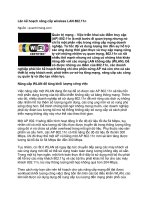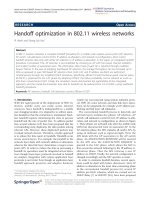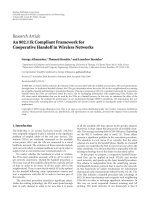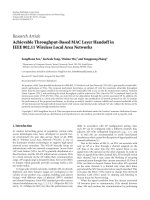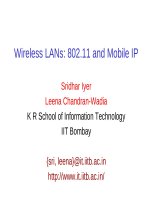Wireless networks - Lecture 26: Wireless LAN/IEEE 802.11
Bạn đang xem bản rút gọn của tài liệu. Xem và tải ngay bản đầy đủ của tài liệu tại đây (531.42 KB, 26 trang )
Wireless Networks
Lecture 26
Wireless LAN / IEEE 802.11
Dr. Ghalib A. Shah
1
Outlines
Overview of IEEE 802.11
IEEE 802.11 Protocols
Architecture
Services
MAC Protocols
► DCF
► PCF
2
Standardization of Wireless Networks
Wireless networks are standardized by IEEE.
Under 802 LAN MAN standards committee.
ISO
OSI
7layer
model
Application
Presentation
Session
Transport
Network
Logical Link Control
Data Link
Medium Access (MAC)
Physical
IEEE 802
standards
Physical (PHY)
3
Overview, IEEE 802.11 Committee
Committee formed in 1990
► Wide attendance
Multiple Physical Layers
► Frequency Hopping Spread Spectrum
► Direct Sequence Spread Spectrum
► Infrared
2.4GHz Industrial, Scientific & Medical shared
unlicensed band
► 2.4 to 2.4835GHz with FCC transmitted power limits
2Mb/s & 1Mb/s data transfer
Draft 5.0 Letter Ballot passed and forwarded to
Sponsor Ballot
► Published Standard adopted in 1997
4
IEEE 802.11 Overview
Goals
•To deliver services in wired networks
•To achieve high throughput
•To achieve highly reliable data delivery
•To achieve continuous network connection.
5
WLAN Requirements
Throughput
Number of Nodes/Scalability
Connection to Backbone LAN
Service Area: 100 to 300 m
Power Consumption
Transmission Robustness and Security
Collocated network Operation
License-free operation
Handoff/Roaming
Dynamic Configuration
6
IEEE 802.11 Protocols
► IEEE 802.11a: PHY Standard : 8 channels : 54 Mbps : 5 GHz band: OFDM.
► IEEE 802.11b: PHY Standard : 3 channels : 11 Mbps : 2.4 GHz band: FHSS,
DSSS.
►
►
►
►
IEEE 802.11d: MAC Standard : operate in variable power levels :
IEEE 802.11e : MAC Standard : QoS support : EDCF.
IEEE 802.11f: Inter-Access Point Protocol : 2nd half 2002
IEEE 802.11h: Supplementary MAC Standard: Enhanced version of 802.11a
to support European Regulatory provides TPC and DFS.
► IEEE 802.11i: Supplementary MAC Standard: Alternative WEP
► IEEE 802.11n: 100 +Mbps : Enhancement to 802.11g using MIMO
►
IEEE 802.11s : mesh networking extension
IEEE 802.11 Architecture
WLAN is based on cellular architecture
Each cell/Basic Service Set (BSS) is controlled by a
base station/Access Point (AP).
Access Points are connected with backbone called
Distribution System (DS).
The whole interconnected WLAN through DS form
Extended Service Set (ESS) as a single layer in OSI
model.
Mobile Station (MS) in BSS with no connection to other
BSSs form Independent BSS (IBSS).
8
Wireless LAN / IEEE 802.11
Fixed Host
IBSS
Distribution System
Access Point
Mobile Host
Basic Service Set
Expanded Service Set
9
ESS
10
Access Point functions as a bridge and a relay
point.
In BSS, MS communicate through Access Point
IBSS is typically an ad hoc network, where
station communicate directly.
To integrate 802.11 with 802.2 (Wired LAN), a
portal is used.
Portal is a device such as bridge or router
attached to DS.
11
802.11 Services
IEEE 802.11 defines nice services.
Three services for WLAN access and
confidentiality.
Six services used to support delivery of MAC
Service Data Unit (MSDU) between stations.
12
Messages Distribution in ESS
Two services involved in distribution of
messages within DS.
► Distribution
• Primary service used to exchange MAC frames between
stations of two BSSs.
• Source sends to AP of one BSS, which sends to DS. DS
then sends to AP of the destination.
• Message transport in DS is beyond the scope of IEEE
802.11 standard.
13
► Integration
• Enables transfer of a data between a station on an IEEE
802.11 LAN and a station on an integrated IEEE 802.x LAN
(Wired LAN).
• It takes care of any address translation and media
conversion logic
14
Association-Related Services
Three services are implemented
► Association:
•
•
Establishes an initial association between a station and an AP
AP can communicate its identity to other APs within ESS to
facilitate routing and delivery of addressed frames.
► Re-association
•
Enables an established association to be transferred from one AP
to another
► Disassociation
•
A notification from either a MS or AP that an existing association
has terminated.
15
Access and Privacy Services
► Authentication
•
•
Establishes the identity of stations.
However, IEEE 802.11 requires mutually acceptable, successful
authentication before association.
► De-authentication
•
Invoked to terminate existing authentication
► Privacy
•
Standard provides optional use of encryption to assure privacy
16
17
IEEE 802.11 Medium Access Control (MAC)
MAC Layer provides three functions
► Reliable data delivery
► Medium access control
► security
18
IEEE 802.11 Protocol Architecture
Logical Link Control (LLC)
Contentionfree
Service
Contention
Service
Point Coordination Function (PCF)
Distributed Coordination Function (DCF)
802.11
2.4 GHz
FHSS
802.11
2.4 GHz
DSSS
802.11
Ird
802.11a
5 GHz
OFDM
802.11b
2.4 GHz
DSSS
19
802.11g
2.4 GHz
OFDM
Reliable Data Delivery
Reliability at TCP level?
► Significant delay due to wait timers
Reliability at MAC
► Quick fix
► Hop by hop ACK at MAC as atomic operation.
20
MAC Protocol
Two types of algorithms:
► Distributed access protocol
• Distribute the decision to transmit
► Centralized control
• Better in ESS, when AP connected to DS
21
Distributed Coordination Function (DCF)
DCF sub layer uses CSMA algorithm
Collision detection as in Ethernet is not
possible in wireless comm.
It implements collision avoidance (CA)
algorithm.
It uses a set of delays of different periods
called inter-frame space (IFS)
22
CSMA/CA
A Station willing to transmit senses the medium.
If the medium is busy, defers
If idle, wait for Distributed Inter-Frame Space (DIFS) or
Exponential back off.
23
CSMA/CA Algorithm
Frame to
transmit
Medium
Idle?
No
Yes
Wait IFS
Wait IFS
Still
Idle?
Wait until
Trans ends
No
Yes
Transmit frame
Still
Idle?
No
Yes
Exp b/o while
Medium idle
If medium becomes busy during the backoff
time, the backoff timer is halted and
resumes when the medium becomes idle.
Transmit frame
24
Example
A is transmitting a frame when B, C and D sense the channel.
B, C, and D run their random number generator to get a back off
time
station C draws the smallest number followed by D and B.
After completion of A:
►
►
►
►
B, C, D wait for the IFS period and start their counters.
C finishes first and starts transmission, after checking again whether
the medium is idle.
B and D freeze their counters.
After completion of C: B and D wait for the IFS period and (re-) start
their counters
25
